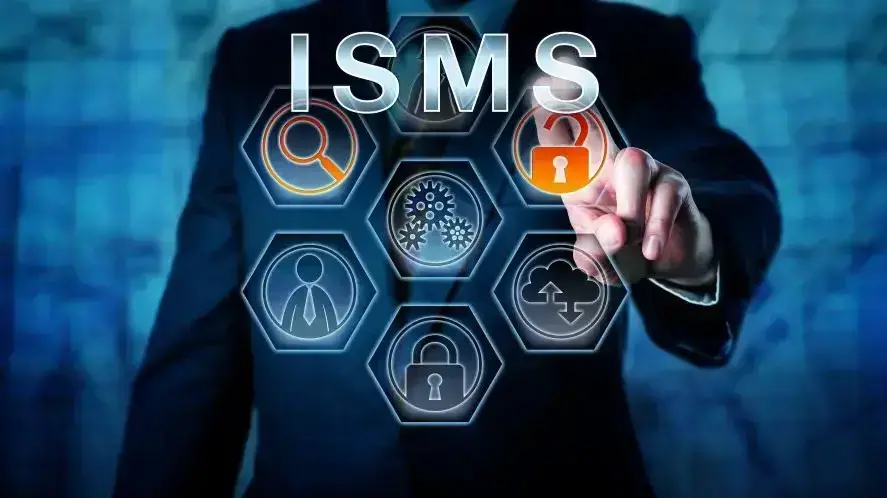An Information Security Management System (ISMS) is a structured framework of policies and procedures designed to manage an organization's sensitive data and protect it from security breaches.
It helps you identify and manage the risks and opportunities related to your essential information and assets. Using a digital ISMS, organizations can simplify compliance management, reduce manual tasks, and maintain team consistency.
This helps keep your organization safe from security problems and reduces the effects of any issues that might happen. You can follow different rules with an Information Security Management System, including the GDPR (General Data Protection Regulation) and ISO 27001 certification. The ISO certification mainly focuses on protecting five important parts of information security. The latter mainly focuses on protecting five key components of information security.
TL;DR:
An Information Security Management System (ISMS) is a structured framework that protects company data through defined policies, risk management, and continuous improvement. It helps meet compliance standards like ISO 27001, GDPR, and HIPAA while reducing security threats and ensuring business continuity. By identifying risks, implementing controls, and auditing regularly, an ISMS strengthens data protection, builds client trust, and proves your organization’s commitment to security and compliance.
Why is an ISMS important?
An ISMS is important because it helps protect your company's data from theft, leak, or misuse. It gives you a clear system for handling security, so you know where your sensitive data is, who can access it, and what to do if something goes wrong.
This reduces the risk of data breaches, saves you from significant losses, and helps you recover faster if something bad happens. It also helps you follow data protection laws like GDPR or HIPAA, which many companies are required to follow.
Having an ISMS shows your customers and partners that you take security seriously, which builds trust. As your company grows, it ensures that your security practices grow with you instead of falling apart.
Who needs ISMS?
If you handle data you care about, want to avoid breaches, or must show clients/regulators that you take security seriously, you need an ISMS. You don't need to go full ISO 27001 overnight, but the core ideas apply to almost every modern organization.
Here is a clear breakdown of who benefits (and, in some cases, is required) to have it:
Companies handling customer or user data: If you store personal information, payment data, or anything private - think SaaS companies, e-commerce sites, fintech, or healthcare - an ISMS helps protect that data and avoid legal/financial messes if something goes wrong.
Businesses subject to compliance regulations: some industries have strict legal requirements for information security. For example, the healthcare industry must follow HIPAA rules, while the finance sector has to comply with regulations like PCI DSS and SOX. Companies in the EU, or those that have customers in the EU, need to follow GDPR guidelines.
Companies seeking ISO 27001 certification: if you're targeting clients who demand security certifications, like ISO/IEC 27001, you need an ISMS to get certified.It's the core of the whole standard.
Startups scaling up: even if you're small, if you're targeting enterprise clients, they'll expect security controls. Having an ISMS in place (even a lightweight one) makes you look mature and trustworthy.
Enterprises and large organizations: they have too many people, systems, and data flows to manage informally. An ISMS keeps things organized, consistent, and auditable.
Organizations with remote teams or distributed infrastructure: the more spread out your operations, the higher the chance of misconfigurations, phishing, and data leakage.
How does an ISMS work?
An ISMS helps protect information in your organization. It starts by determining your data, what risks exist (like hackers, mistakes, or system failures), and what needs the most protection. Then, you set up rules, tools, and processes to reduce those risks, like access controls, regular backups, employee training, and plans for handling problems.
An ISMS is not just a one-time setup; you keep working on it as you regularly check and improve it using a simple plan as listed below:
First, you identify risks, set goals, and create security rules.
Next, you implement the plan by installing controls, training staff, and writing down processes.
Then, you monitor everything, conduct audits, and review logs to see what's working.
Finally, you fix issues, improve weak areas, and update policies as needed.
Everything is tracked and documented, so you know what's happening. An ISMS helps you stay secure, compliant, and in control, especially as threats and your business change.
What do you need to implement your ISMS?
Before setting up your digital ISMS, especially if you're aiming for ISO 27001 compliance, there are a few key things to sort out:
A dedicated team: setting up an ISMS takes time and focus. You need a manager or a small team who understands security and can commit to running the project. After it's up and running, they'll also handle ongoing updates and oversight.
A clear view of your resources: an ISMS isn't just about digital data. It also covers your software, hardware, physical locations, employees, and suppliers. You'll need a way to keep track of all these so you can assess risks properly and protect what matters.
Easy-to-follow policies for handling data breaches: your ISMS should explain precisely what to do if a data breach happens. These rules should be written in a way that's easy for staff and partners to understand and follow. That way, everyone knows how to respond and keep things under control.
Strong communication and employee engagement: People must understand why the ISMS exists and what its role is in securing information. It can't just sit in a folder collecting dust. You may need to run training sessions or send out regular updates to keep security in mind.
Tools to manage third-party and supply chain risks: your partners and vendors might also have access to sensitive data. Your ISMS should include steps for checking their security practices and ensuring they don't become weak points in your system.
Support for audits and certifications: if you're going for ISO 27001 certification, a third-party auditor will need to review your ISMS. The process has two stages, and you'll need to stay compliant by running internal audits regularly. Full certification lasts three years, but ongoing reviews are part of the deal.
How to Implement an ISMS
Implementing an Information Security Management System follows the Plan-Do-Check-Act (PDCA) cycle. It starts with creating an ISMS policy that outlines why you're doing it, what you aim to achieve, and how the system will be managed, including who's in charge and what resources they'll need.
Next, you identify and classify the information and assets you want to protect based on their sensitivity or value.
Once clear, you set up the structure and tools needed to run the ISMS and manage risks effectively. You also need to build control mechanisms to check regularly if the system is working as expected.
Then, the ISMS should be implemented across daily operations, with all processes documented and followed. Over time, you track results using performance data and key metrics to understand how well it's working. Based on these results, you fix any issues, improve weak spots, and take steps to reduce future risks.
Finally, management should review the ISMS at least once a year to ensure it remains aligned with the company's goals and make necessary changes.
Other standards an ISMS must comply with besides ISO 27001
Depending on the industry, region, and type of data being handled, an ISMS may need to comply with several other standards besides ISO/IEC 27001. ISO/IEC 27002 is a companion standard to ISO 27001, offering detailed guidance on implementing its controls.
In the U.S., the NIST Cybersecurity Framework is widely used, especially by government-related organizations. Companies that offer cloud services or handle customer data often follow SOC 2, which focuses on security, availability, and privacy. Larger organizations might use COBIT for broader IT governance. If your business handles credit card payments, PCI DSS is mandatory. In healthcare, HIPAA sets strict rules for protecting patient data.
For companies operating in or with the EU, GDPR enforces data protection and privacy requirements, which an ISMS can support. ISO/IEC 27701 extends ISO 27001 to include privacy management, making it useful for GDPR compliance. Cloud providers may also use CSA STAR to prove their security and trust practices. An ISMS often starts with ISO 27001 as the foundation, but other standards are based on specific business needs.
Conclusion
An ISMS is more than just a set of security rules - it's a structured way to protect your company's data, stay compliant with laws, and build trust with customers and partners.
Whether you're a small startup or a large organization, having an ISMS helps you understand your risks, respond to threats, and improve your security over time. It keeps your team aligned, your operations more secure, and your business better prepared for the future.
Frequently Asked Questions
How to check if a website is GDPR compliant?
To check if a website is GDPR compliant, look for a clear privacy policy, consent mechanisms for data collection, options to manage cookies, and features allowing users to request access, correction, or deletion of their data.
Also, verify if the site uses encryption and follows data minimization practices.
How does LiteSpeed Hosting improve website security?
LiteSpeed Hosting enhances website security with built-in protection features that safeguard data and prevent vulnerabilities. Free SSL certificates encrypt visitor information, ensuring secure connections. Additionally, daily backups protect against accidental data loss, allowing for easy restoration when needed. The LiteSpeed Web Server also includes security optimizations that help mitigate malicious traffic and unauthorized access attempts.
Are there security concerns associated with SSR?
Yes, security concerns can arise with SSR if not implemented securely, such as improper data handling on the server.
How can I ensure data security with chatbots?
To protect customer data, implement encryption, access control, and regularly update your chatbot's security measures. Comply with data protection regulations and provide transparent privacy policies.

Joel Olawanle is a Software Engineer and Technical Writer with over three years of experience helping companies communicate their products effectively through technical articles.
View all posts by Joel Olawanle



















